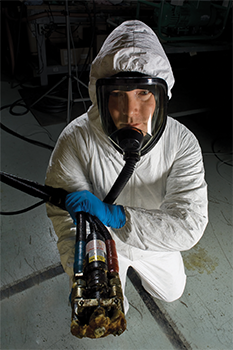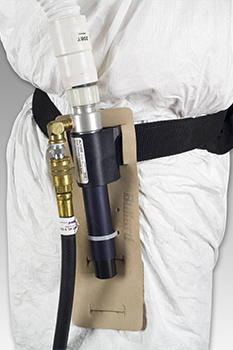
Safety First

Spray Foam Magazine – There are so many aspects to consider when building or redesigning a spray foam rig; the process can be overwhelming. The equipment, machines, spray guns, hoses and transfer pumps are all to be considered in the design. However, there is one crucial factor that is sometimes overlooked in the excitement of setting up a rig, and that is the requirements for proper safety equipment. The Spray Foam Magazine team (SFMT) take safety on the jobsite and in the workplace very seriously. We decided to speak with some experts in this field to get their take on setting up a rig with one of the most important elements of safety that can initially be overlooked: the supplied air.
In 1898, Edward Dickinson Bullard equipped San Francisco’s gold and copper miners with equipment and when his son E.W. Bullard returned from World War I, they labored together to create safety equipment for miners. Today, this passion for innovation and safety runs through the veins of the company and the people who work there. The safety equipment is all designed for the experts in the industries Bullard serves, helping keep workers safe in infrastructure, energy, pharmaceutical manufacturing, healthcare, emergency responder roles, and many other industries, including spray polyurethane foam.
Certified spray foam contractors will be aware of safety in the workplace and on their rig. They consider employee training, a well-equipped first aid kit, emergency eyewash stations, fire extinguishers, bracing material to stop equipment and drums moving around the rig and any electrical wires run inside conduit to reduce the risk of an electrical fire. Conversely, the correct safety masks and powered air respirators need to be carefully considered.
SUPPLIED AIR
Why is supplied air so important to consider while spraying foam? When working on indoor applications, fresh air is mandatory per OSHA guideline. For exterior applications, an air purifying respirator (APR) can be used with the correct filter cartridges, but a supplied-air respirator (SAR) is still strongly recommended. Both SAR and Clean Air Box (CAB) systems typically need to be specified during the rig design (prior to build) as a CAB / Vortex will result in greater compressed air requirements. This usually means having the following installed in the rig:
- A bigger compressor
- Larger generator
- Potentially a larger rig or trailer
POST RIG BUILD
A free air pump/respirator can be added post rig build since it does not require additional compressed air or power. There is also a huge difference in Assigned Protection Factor (APF) ratings. APF, means the workplace level of respiratory protection that a respirator or class of respirators is expected to provide to employees when the employer implements a continuing, effective respiratory protection program. A tight-fitting mask carries an APF rating of 10, moving up from this to a spectrum mask in 25 APF and a canister is around 50 APF, but a SAR or supplied air, gives you a 1000 APF. The takeaway from all of this is that the SAR gives better protection with better comfort.
Summary of a free air pump:
- Free Air – low pressure pumps
- Highly portable
- Can be added after the rig build /purchase
- High protection
- Lower upfront cost
- Reduced ability to cool or heat the worker
RESPIRATOR HOOD
A respirator hood is a unique air delivery system which delivers airflow to the breathing zone. This is a great way to have reusable comfort with the head moving with the hood. According to Bullard a well-designed hood is compatible with powered respirators (PAPR) and supplied air (SAR) and has the following features:

- Wide angle lens enables your peripheral vision allowing you to see objects around you, sense motion, view objects and communicate easily with coworkers
- Taped and sealed seams providing additional protection for liquid penetration
- Reusable comfort suspension is adjustable ensuring a customized fit
- Peel-off lens help you manage overspray and increases overall productivity
- Well designed to have superior comfort and protection, while delivering airflow directly into the worker’s breathing zone.
- Third party tested
- No fit testing required
FULL FACE RESPIRATOR
Wearing a full-face respirator has the obvious benefit of more protection than non-powered half mask respirator this is due to the blower creating positive pressure inside the facepiece under most work conditions, which minimizes inward seepage of potentially contaminated air.
The full-face respirator also has the advantage of the wearer being able to see clearly in addition to it allowing free movement and maneuverability. A well-designed full-face respirator mask by an established manufacturer will features state-of-the-art design to lower breathing resistance. For example, Bullard’s full-face respirators feature state-of-the-art design to lower breathing resistance, while preset upper straps make it easy to put on/take off. Other features to consider are:
- Scratch-resistant wraparound faceplate allows for wide field-of-vision
- Components can be replaced by hand in seconds
- Snap together parts making assembly and maintenance quick and efficient without requiring special tools
- Compatible with full-brim or cap-style hard hats
SUPPLIED AIR CLIMATE CONTROL DEVICE
Some features and benefits of a well-designed supplied air climate control device are:
- Cool tube assemblies
- Hot/cold tube assemblies
- Dual-cool tubes
- Cools or warms incoming air from a compressed breathing air source.
- Cools incoming air from low-pressure air sources such as ambient air pumps
IT’S A MATTER OF MATH
Taking safety equipment into account is crucial, but like any piece of equipment, it can add weight to the rig. If having the benefit of choosing a new rig, these pieces of equipment can be designed and calculated when deciding on the ideal rig size. If the rig is heavy yet undersized, it can lead to problems from the rig’s framing to the axles. The height and width of the rig also needs to be accurate to insert and remove equipment with ease. Choosing the correct proportioner is fundamental as it will help decipher the rest of the machineries required to make sure the spray foam rig has the basic equipment to keep the rig running.

The AC1000 Cool Tube is designed to supply a continuous flow of cool air to a Bullard supplied air respirator. It can be secured around your waist during use.
The proportioner and air compressor will also determine the size of the generator and thus the size of the spray foam rig. It is therefore crucial to speak to a rig manufacturer about safety equipment and the correct power needed for compressed air supply for supplied air respirators (SAR).
If deciding to add additional equipment to an already purposed rig, it may be an idea to seek out expert advice from either your original rig manufacturer, or an experienced rig manufacturer to guide you on how to adapt the rig to any additional equipment.
Safety in the spray foam industry is a top priority for contractors, employers, and clients. Ensuring there is access to safety training, equipment, and products on the rig and the workspace, will help reduce accidents. Don’t ever forget improving worker safety starts with education and in the rig.
For use by SprayFoamMagazine.com & Spray Foam Magazine














